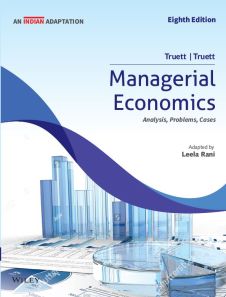Managerial Economics, 8ed, (An Indian Adaptation)
ISBN: 9789354640759
648 pages
For more information write to us at: acadmktg@wiley.com

Description
The contents of this Adapted Edition have been restructured and enhanced to include more recent knowledge and to fit the Indian context. Based on the suggestions from readers of the earlier editions, the text has been extensively updated throughout, with some latest decision-making examples to discuss the foundational principles of managerial economics and strengthen students’ critical thinking skills.
Part 1 The Firm and Its Environment
1 Introduction, Basic Principles and Methodology
1.1 Managerial Decisions and Principles in Today’s Economy
1.2 Economists and the Application of Managerial Economics
1.3 Our Approach to Problem Solving
1.4 Organization of this Book
1.5 Review of Basic Demand and Supply Analysis
1.6 Carryover to Analysis of Other Markets
2 Revenue of the Firm
2.1 Advertising, Consumer Demand and Business Research
2.2 Demand and Revenue Concepts
2.3 Determinants of Demand
2.4 A Note on Determinants of Supply
2.5 Elasticity of Demand
3 Demand Analysis and Estimation
3.1 Market Surveys
3.2 Demand Estimation with Regression Analysis
3.3 Market Experiments
4 Economic Forecasting
4.1 Types of Economic Forecasts
4.2 Two Major Kinds of Data
4.3 Factors Affecting Economic Variables
4.4 Forecasting Methods
4.5 Accuracy of Forecasts
Part 2 Production, Cost and Profit Maximization
5 Production Analysis
5.1 The Production Function and the Long Run
5.2 Product Curves and The Short Run
6 Cost of Production
6.1 Types of Costs
6.2 Costs in the Long Run
6.3 Costs in the Short Run
6.4 Relationship of Short-Run Cost Curves to Short-Run Product Curves
6.5 Relation of Short-Run to Long-Run Average Costs
6.6 The Learning Effect
6.7 Economies of Scope
6.8 Choosing the Optimal Plant Size: An Example
6.9 Estimation of Cost
7 Profit Analysis of the Firm
7.1 Profit Maximization
7.2 Shutdown Point
7.3 Breakeven Analysis
7.4 Profit Maximization Versus Breakeven Analysis
7.5 Incremental Profit Analysis
7.6 Producer’s Surplus
Part 3 Markets and The Behavior of The Firm
8 Perfect Competition and Monopoly: The Limiting Cases
8.1 Perfect Competition and Its Setting
8.2 Monopoly and Its Setting
9 Monopolistic Competition and Oligopoly
9.1 Monopolistic Competition: A Case of Many Firms
9.2 Duopoly: An Oligopoly with Two Firms
9.3 The Question of Entry
9.4 The Kinked Oligopoly Demand Curve:
9.5 Tacit Collusion and Price Leadership
9.6 Perfect Collusion—The Cartel
9.7 Production with Multiple Plants
9.8 Product Market Structures: Recap and Comparison
10 Games, Information, and Strategy
10.1 Strategy and Types of Games
10.2 Some Game Theory Examples
10.3 Multiple Equilibria, Sequencing and First-Mover Advantage
10.4 Cooperative Games
10.5 Repeated Games
10.6 Trees and Sequential Games
10.7 Decision Making and the Economics of Information
10.8 Moral Hazard
10.9 Signaling
11 Topics in Pricing and Profit Analysis
11.1 Markup Pricing
11.2 Decisions Involving Multiple Products
11.3 Price Discrimination
11.4 Two-Part Pricing (Access Fees)
11.5 Bundling
11.6 Alternatives to Profit Maximization
12 Factor Markets and Profit-Maximizing
12.1 Profit-Maximizing Employment of One Variable Input
12.2 Determination of Equilibrium Prices for Inputs: Perfect Competition in the Input Market
12.3 Determination of Equilibrium Prices for Inputs: Monopsony in the Input Market
12.4 Determination of Equilibrium Prices for Inputs: Bilateral Monopoly in the Input Market
Part 4 Analysis of Project Decisions
13 Fundamentals of Project Evaluation
13.1 Capital Budgeting and Project Analysis
13.2 Costs in New Undertakings
13.3 Stream of Receipts or Returns
13.4 A Simple Capital Project Analysis
13.5 Project Yield or Rate of Return
13.6 Project Ranking in Capital Budgeting Analysis
13.7 Cost of Capital and the Discount Rate
14 Risk in Project Analysis
14.1 Certainty Versus Risk
14.2 Risk in Economic Analysis
14.3 Risk-Return Indifference Curves
14.4 Probability and Uncertainty
14.5 Application of Probability Analysis to Risk
14.6 Evaluating Risky Streams of Receipts
14.7 Probability Approach to Multiple Project Alternatives
14.8 Acceptable Shortcuts to Risk Analysis
14.9 Externalities and their Nature
Part 5 The Firm and The Public Sector
15 Economics of Public Sector Decisions
15.1 Micro- Versus Macroeconomics in Public Sector Analysis
15.2 The Public Sector’s Product
15.3 Resource Allocation and the Supply of Public Goods
15.4 Cost-Benefit Analysis: A Procedural Outline
15.5 Public Investment and the Discount Rate
15.6 Cost-Benefit Analysis and Divergent Public Objectives
15.7 Pitfalls of Cost-Benefit Analysis
15.8 The Future of Cost-Benefit Analysis
16 Legal and Regulatory Environment of the Firm
16.1 Managers and the Law
16.2 Types of Law Affecting the Firm
16.3 Antitrust and Business Practices Laws
16.4 Administrative Agencies and the Law
16.5 The Regulated Industries
16.6 Whose Interests do Regulators Serve?
16.7 Regulation of “Unregulated Industries”
16.8 Laws, Regulations, and ahe Firm’s Strategy
16.9 Recent Impactful Regulatory Issues from Around the World
Summary
Questions
Glossary
Index

